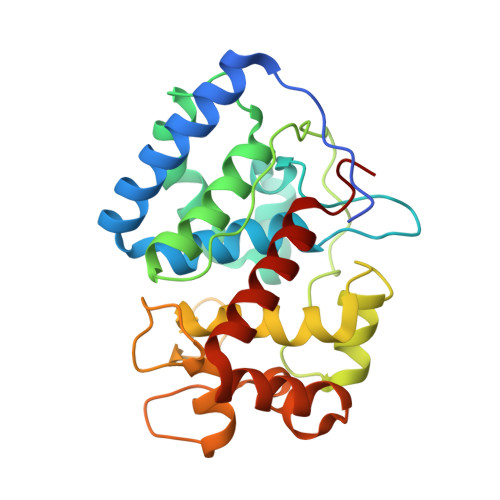Crystal Structure of the Ascorbate Peroxidase-Salicylhydroxamic Acid Complex
Sharp, K.H., Moody, P.C.E., Brown, K.A., Raven, E.L.(2004) Biochemistry 43: 8644
- PubMed: 15236572
- DOI: https://doi.org/10.1021/bi049343q
- Primary Citation of Related Structures:
1V0H - PubMed Abstract:
Ascorbate peroxidase is a bifunctional peroxidase that catalyzes the H(2)O(2)-dependent oxidation of both ascorbate and various aromatic substrates. The ascorbate binding site was recently identified as being close to the gamma-heme edge [Sharp, K. H., Mewies, M., Moody, P. C. E., and Raven, E. L. (2003)Nat. Struct. Biol. 10, 303-307]. In this work, the X-ray crystal structure of recombinant soybean cytosolic ascorbate peroxidase (rsAPX) in complex with salicylhydroxamic acid (SHA) has been determined to 1.46 A. The SHA molecule is bound close to the delta-heme edge in a cavity that connects the distal side of the heme to the surface of the protein. There are hydrogen bonds between the phenolic hydroxide of the SHA and the main chain carbonyl of Pro132, between the carbonyl oxygen of SHA and the side chain guanadinium group of Arg38, and between the hydroxamic acid group and the indole nitrogen of Trp41. The structure provides the first information about the location of the aromatic binding site in ascorbate peroxidase and, together with our previous data [Sharp, K. H., et al. (2003) Nat. Struct. Biol. 10, 303-307], completes the structural description of the binding properties of ascorbate peroxidase. The mechanistic implications of the results are discussed in terms of our current understanding of how APX catalyzes oxidation of different types of substrates bound at different locations.
Organizational Affiliation:
Department of Chemistry, University of Leicester, UK.

















